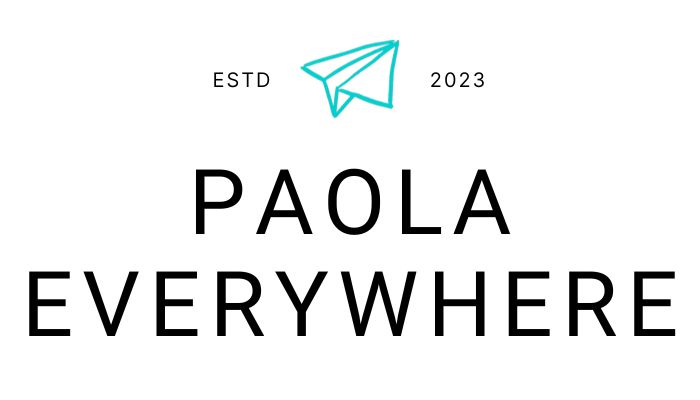Morocco is a country that surprises you at every turn, with landscapes and atmospheres that shift constantly as you travel. This route is the classic journey taken by most visitors on their first trip, usually starting from Casablanca or Marrakech. It leads you across imperial cities, mountain passes, and remote Berber villages before reaching the golden dunes of the Sahara. In just over a week, you’ll witness living traditions and genuine hospitality. You can also follow this itinerary independently, setting your own pace and relying on local guides and a private driver to make the journey smooth and stress-free.
Table of Contents
Casablanca: Hassan II Mosque, Art Deco Buildings and Modern Morocco
The first stop of my tour in Morocco was the Hassan II Mosque. It’s one of the largest in the world, rising directly above the Atlantic. Its refined mosaics and carved woodwork showcase the remarkable craftsmanship that defines Moroccan religious architecture.
PLAN YOUR TRIP TO MOROCCO
The easiest way to stay connected in Morocco is with a Holafly eSIM: unlimited data for maps, navigation and instant sharing on WhatsApp without worrying about your data running out.
Travelling in Morocco without insurance is never a good idea, as healthcare is private. If you’re travelling independently, a Heymondo travel insurance protects you from unexpected costs and lets you explore with peace of mind.
Use my links to purchase your eSIM and travel insurance with an exclusive reader discount!
The city is often skipped by travellers who only stop to visit the mosque. I did the same on my very first trip to Morocco. Yet, the city deserves at least two days, and on my next visit, I returned to explore it properly. You can stroll along the Corniche, admire elegant Art Deco buildings, browse lively markets and experience the mosque’s hammam.
Casablanca may not be the country’s most touristic destination. Still, it’s an ideal gateway thanks to the many low-cost flights arriving daily. Cosmopolitan, energetic and surprisingly modern, it offers a smooth introduction before you venture into the imperial cities and desert landscapes further south.

Rabat: A Capital Between the Ocean, the Kasbah and the Medina
The second stop on my journey was Rabat, the country’s administrative capital. It is a large city, yet it feels calmer than many other destinations, a brief but meaningful pause. Rabat immediately stands out for its relaxed and welcoming atmosphere.
I visited the kasbah, atmospheric even if quite popular with tourists, and took a stroll through the medina. Here, the medina is smaller and more compact than those of Fez or Marrakech. This scale makes it far less chaotic and far more accessible.
Rabat also has picturesque sea views and reveals a more authentic, less touristy side of the country. A simple walk through its whitewashed alleys trimmed with blue is enough to leave you with a vivid and unexpectedly charming memory of the city.
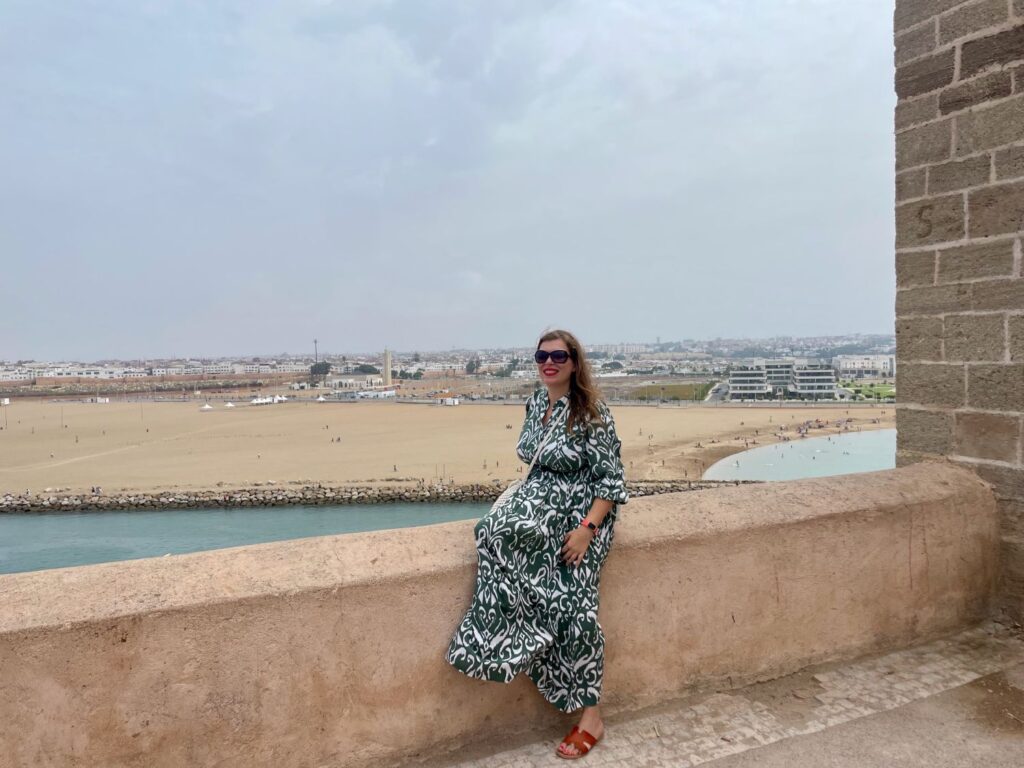
Chefchaouen: Exploring the Quiet Magic of the Blue City
Hidden in the Rif Mountains, Chefchaouen surprises you even when you think you know what to expect. You have almost certainly seen its blue-painted alleys and colourful doors it in photos. Seeing it in person is something else entirely. The city’s colours create an atmosphere that feels almost dreamlike.
I arrived a little sceptical, as highly popular destinations often risk disappointment. Yet walking through Chefchaouen felt like stepping into a postcard. Every corner made me stop, look around and take another photo. Its charm is far greater than any picture can ever convey.
Despite being very touristy, the city has a relaxed, almost suspended atmosphere that lets you enjoy it without rushing. It is compact and perfect for wandering through its lanes, browsing market stalls and reaching the Ras Elma river, where women still wash carpets by hand and vendors keep fruit cool in the running water. Life here flows at a gentle and authentic rhythm.
You can also climb to the Spanish Mosque for panoramic views over the blue city and surrounding mountains. Alternatively, explore the kasbah at the heart of the medina, with its quiet garden and centuries-old walls. Each viewpoint reveals a different shade of Chefchaouen’s beauty.
Chefchaouen stays with you long after you leave. Not only for its unique palette of blues but also for its welcoming atmosphere, unlike anywhere else in Morocco. It is a place that leaves a lasting imprint on your travels.
I recommend staying at Dar Laman Riad in Chefchaouen, a charming Berber-style guesthouse with a beautiful rooftop overlooking the town. The owner, a true Berber, will be more than happy to guide you with local tips and recommendations. He can really help you make the most of your time in the Blue City.
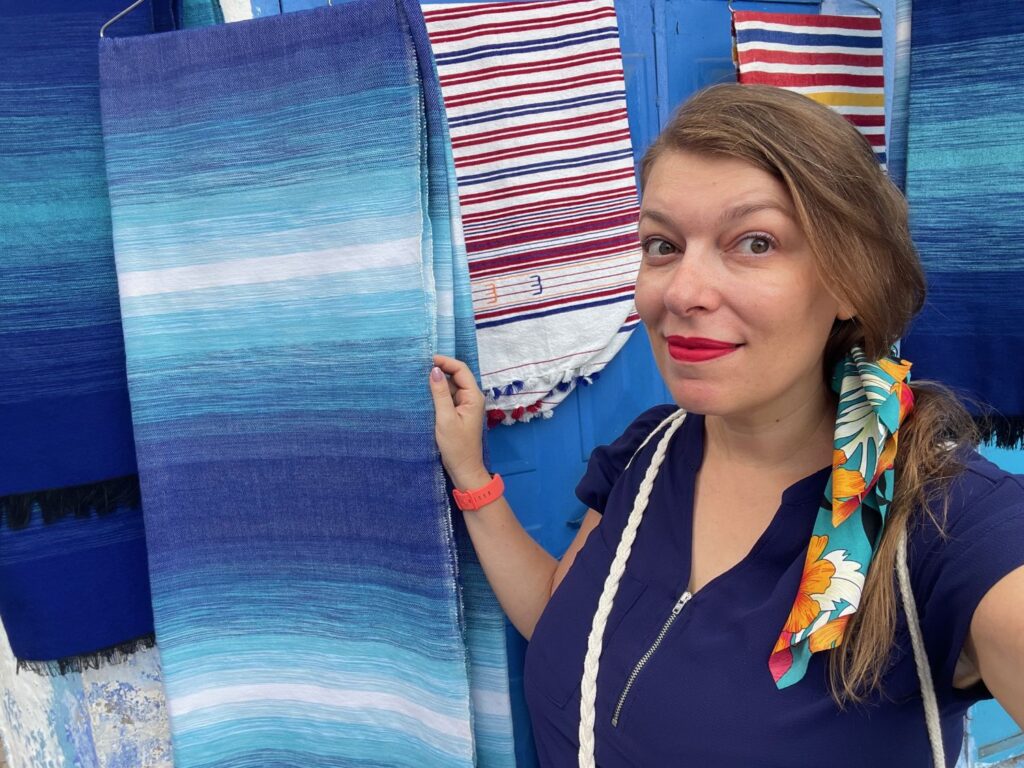
Meknes: The Authentic Soul of a Lesser-Known Imperial Capital
Among Morocco’s imperial cities, Meknes is perhaps the least known, and that is exactly what makes it special. The atmosphere feels different from Fez or Marrakech. The medina is lively but not chaotic, the streets are quieter and the overall pace is slower. Meknes offers an experience that feels more intimate and unfiltered.
With a local guide, I discovered not only the city’s monuments but also its everyday life and traditions. She shared insights into Moroccan religion and culture with great passion, turning the tour into something engaging and personal. Her stories brought the city to life in a memorable way.
Contrary to what many guidebooks suggest, Meknes is actually one of the most authentic places for shopping. You can find carpets, ironwork inlaid with silver and other handmade souvenirs at fairer prices, far from the purely tourist-driven dynamics of other cities. Craftsmanship here still follows local rhythms and traditions.
Meknes was a pleasant surprise, showing me a side of Morocco that feels more genuine and less touched by mass tourism. It invites you to explore without rush, meet local artisans and enjoy an atmosphere that stays with you. It leaves you with an authentic and precious memory of the country.
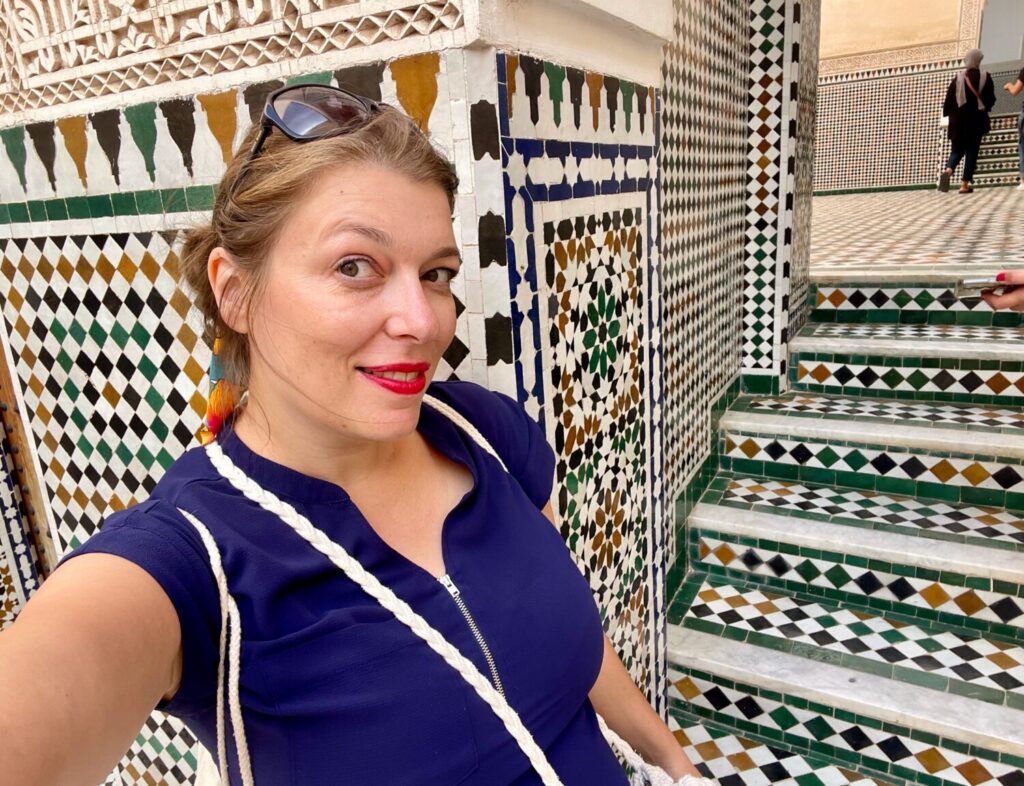
Fez: The Most Captivating Artisan Maze in Morocco
Among Morocco’s imperial cities, Fez is the one that best reflects the country’s authentic, artisan soul. Fez’s medina is one of the largest and oldest in the world and a true labyrinth of narrow, twisting alleys where even locals admit they often get lost. Fez immediately transports you into a world that feels centuries old.
Walking through the medina feels like stepping back in time, surrounded by workshops, madrasas and caravanserais full of history. One of the most iconic places to visit is the Chouara tanneries. They remain one of the most striking symbols of Fez’s artisan heritage.
From the terraces, you see vats of natural dyes while artisans work as they have for centuries, even using pigeon droppings without protection. It is a fascinating sight, although the strong smell is not for the faint-hearted and easily overpowers the sprigs of mint handed to visitors. The tanneries offer an unforgettable experience for all the senses.
It is also worth visiting a madrasa, a beautiful example of Islamic architecture with its intricate woodwork and mosaic-covered courtyards. However, I particularly enjoyed a visit to a traditional Moroccan herbalist, where we learnt how pure argan oil is made and browsed typical products such as spices and fragrant oils. These small encounters reveal the living traditions behind everyday Moroccan life.

The Ziz Gorges: Scenic Landscapes Shaping Your Journey Towards the Sahara
To reach the Merzouga Desert, you first cross the Ziz Gorges, one of Morocco’s most striking natural landscapes. This long valley, shaped by the Ziz River, unfolds between mountains and canyons, with scenery that changes constantly along the way. It is the moment when you truly feel the landscape shifting towards the Sahara.
The route alternates between Berber villages, palm groves and rock formations that change colour with the light. On one side you sense the desert drawing closer, on the other the freshness of the oases breaks the arid horizon and makes the views surprisingly varied. Each bend in the road reveals a completely new perspective.
The gorges are not just a scenic stop; they also offer a chance to observe rural Moroccan life up close. Time seems to move more slowly here, with earth-toned houses blending into the landscape and nature remaining the true protagonist. Pausing along the way helps you breathe in the Middle Atlas air and prepare for the emotional arrival in the Sahara.
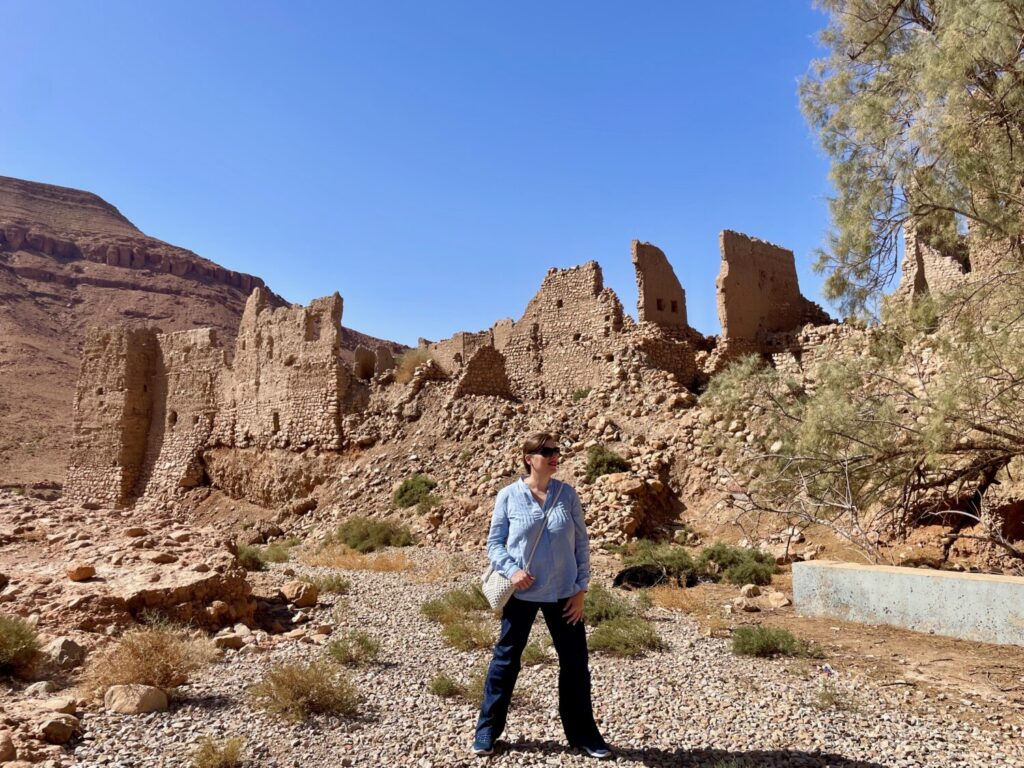
Merzouga Desert Experience: Golden Dunes and Unforgettable Nights Under the Stars
Reaching Merzouga, on the edge of the Sahara and close to the Algerian border, is one of the most powerful moments of the journey. The Erg Chebbi dunes, rising up to 150 metres, are awe-inspiring, especially as light shifts and the sand changes colour.
The first glimpse of the Sahara is a moment you never forget. You can explore the dunes by quad bike or on a camel ride.The sunset camel ride is touristy, yet it helps you imagine how Bedouins once travelled and lets you feel briefly part of their ancient culture.
Spending the night in a desert camp makes the experience even more atmospheric. After a Berber dinner, you sit under the open sky, with music and drums echoing softly between the dunes. The desert night is so clear and star-filled that it feels as though you could reach out and touch the constellations; I even saw two shooting stars. The starry sky is one of my most moving memories of Merzouga.
There are plenty of activities around Merzouga, from jeep excursions along the old Paris–Dakar tracks to visiting a fossil workshop, exploring abandoned wells and stopping in a Berber tent for tea. The desert offers variety and discovery at every turn, yet its atmosphere remains the strongest and most authentic memory of the journey.
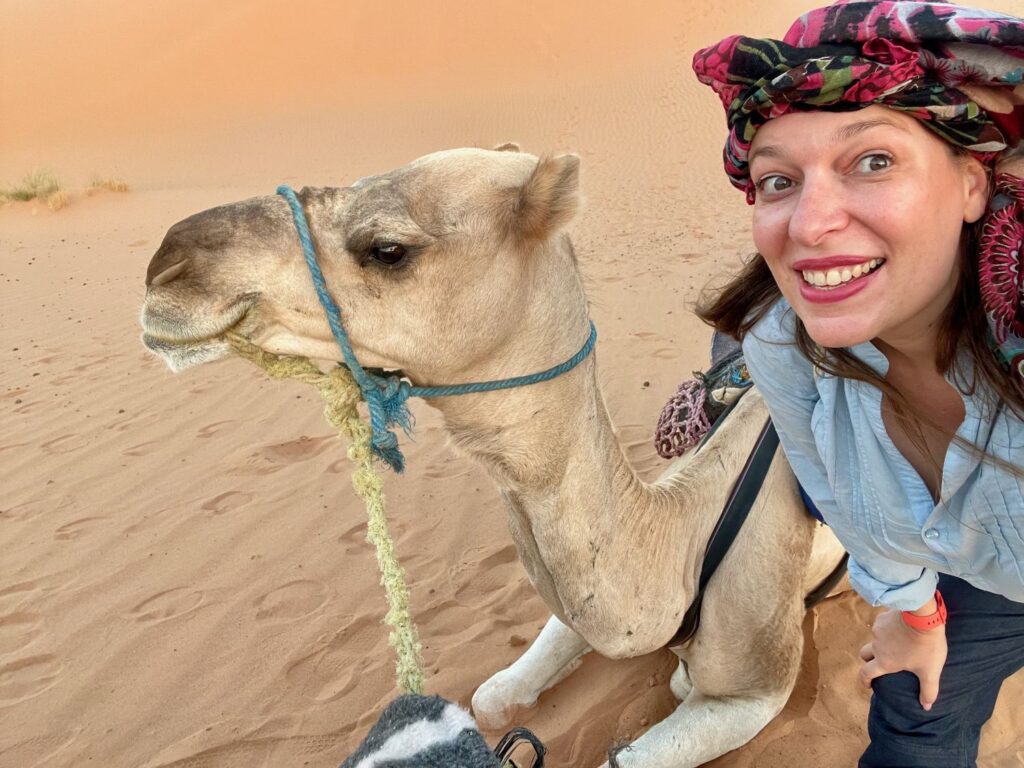
The Dades Gorges: Dramatic Canyon Landscapes Shaped by Wind and Time
Among the most striking natural stops on the journey, the Dades Gorges are a place that truly takes your breath away. The valley is carved by the Dades River and framed by rock formations shaped by wind and time, glowing with intense colours, especially at sunset.
The panoramic road that climbs through the gorges is one of Morocco’s most famous. Its hairpin bends, when viewed from above, form one of the most iconic images of the entire trip and reveal just how unique this landscape is.
It is worth stopping at the viewpoints to take photos and admire the blend of canyon cliffs, palm groves and Berber villages scattered along the valley. Each viewpoint offers a new and unforgettable perspective.
Beyond the views, what stands out most in the Dades Gorges is their authenticity. You can see villages built from earth and straw blending into the mountains, creating the impression that time has slowed to a halt.
I spent the night at Auberge Tissadrine, a hotel with spectacular views over the gorges. I recommend choosing the Auberge Tissadrine not just for the view, but also for the delicious dinner and the generous breakfast. It is the kind of place that radiates tranquillity and makes you wish you could stay longer to absorb every detail of this corner of Morocco.

Ait Ben Haddou: Exploring a UNESCO-Protected Fortified Village
On the road between the desert and the mountains lies Ait Ben Haddou, a kasbah recognised as a UNESCO World Heritage Site. It’s built from earth and straw, with towers and narrow alleys woven together like a maze and its architecture creates one of the most atmospheric settings in all of Morocco.
Walking through its lanes feels like travelling back in time. Despite its fame, a few families still live here, a detail that makes the experience unexpectedly authentic. Ait Ben Haddou is not just an open-air museum but a place where daily life continues quietly behind the ancient walls.
Its magical atmosphere is heightened by its long relationship with cinema. Knowing that films such as Gladiator, Lawrence of Arabia and Game of Thrones were shot here makes you look at every corner with fresh eyes, trying to recognise the scenes you have watched on screen.
From the panoramic viewpoints, you can admire the entire surrounding valley. The contrast between green palm groves, arid mountains and wide open sky stays imprinted in your memory and makes the visit absolutely worthwhile.
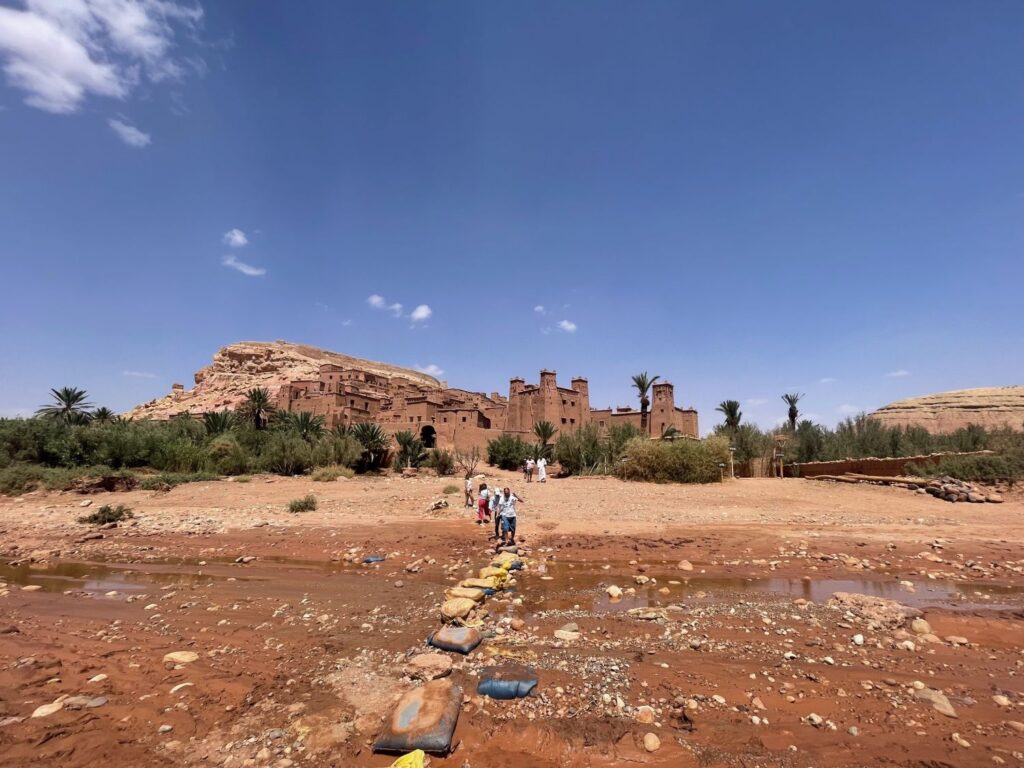
Marrakech: The Red City of Gardens, Souks and Historic Palaces
My tour of Morocco through imperial cities and the desert ended in Marrakech, the famous Red City. It is a destination that never leaves you indifferent: chaotic and noisy at times, but also deeply fascinating and full of contrasts. Marrakech overwhelms you, challenges you and captivates you all at once.
I explored the medina with a local guide. It’s the best way to learn that the souks in Marrakech are not just tourist markets but places where local artisans still work every day. Watching leather slippers, carved lamps or jewellery being crafted by hand felt like stepping back in time. Here, traditions endure despite mass tourism.
Jemaa el-Fna, the most famous square in Morocco, becomes full of life at night with street performers, food stalls and fresh juice vendors. The city also offers remarkable restaurants. From rooftop terraces with breathtaking views to hidden riads with lush gardens, you can savour traditional dishes in a peaceful setting.
Historic sites such as the Bahia Palace and the Ben Youssef Madrasa suffer from overtourism. Yet, they remain essential for understanding the elegance of Moroccan art and architecture. To take a break, I recommend ending your trip as I did in a traditional hammam. It’s a gentle and rejuvenating way to unwind after days spent exploring the city.

What Surprised Me About Morocco: Hospitality, Cats and Berber Traditions
Beyond the places I visited, Morocco impressed me with many details I did not expect. Before my trip, I pictured only imperial cities and desert landscapes, yet once there, I discovered far more than that. It is a country made of nuances that reveal themselves slowly.
What stays with you most is the sense of welcome. Everywhere I went, people greeted me with warmth and genuine openness. Guides and locals alike surprised us with their tolerance, their willingness to share their culture and the deep spirituality woven into everyday life.
And then there are the cats, as much a part of Morocco’s landscape as its mosques or souks. You find them everywhere: sitting in front of Chefchaouen’s blue doors, stretching in the sun among ancient stones, wandering through busy squares. It is impossible not to notice how loved and respected cats are. For someone like me who adores cats, this made the journey even more special.
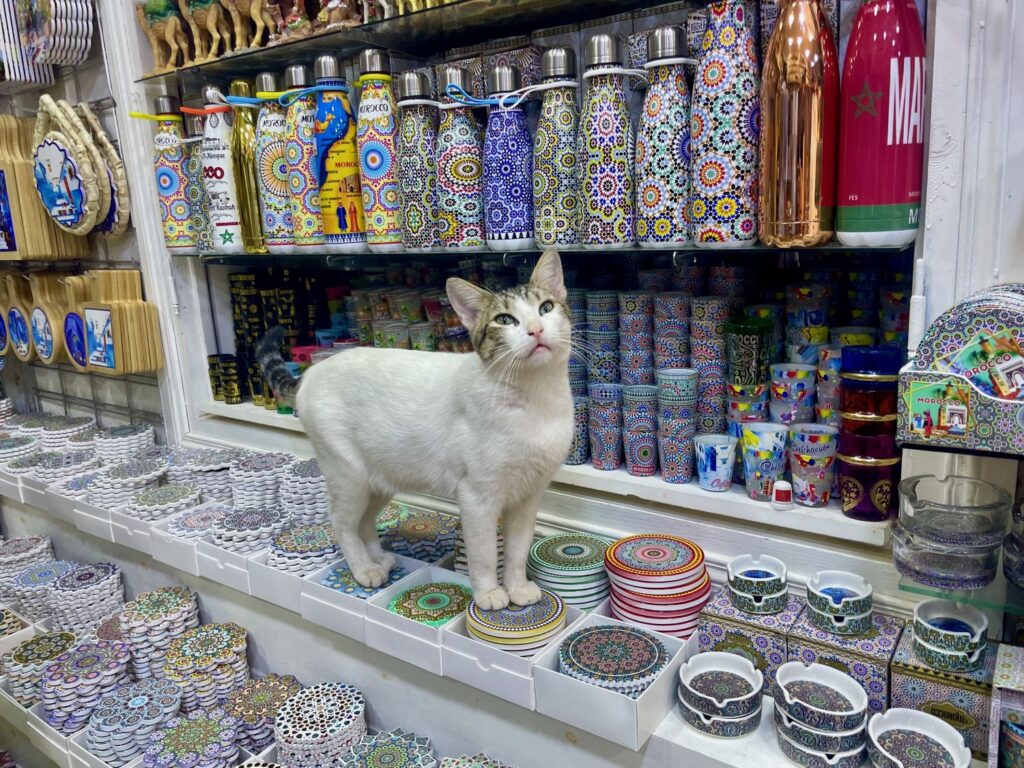
The craftworks are another aspect that truly struck me. Each handmade object tells a story of skill and heritage. Watching artisans at work in the souks is an authentic experience: hand-stitched leather slippers, intricately carved lamps, and unique jewellery. And then the Berber carpets, real works of art that carry centuries of tradition.
Berber culture is deeply rooted and endlessly fascinating. The Berbers define themselves as Amazigh, “free people”. Their community has long protected its identity until its language and culture were officially recognised as an integral part of Moroccan society.
Morocco is like this: a place that keeps surprising you, not only with grand monuments but with small details that stay in your heart. If you have already visited Morocco or you are planning your first trip, feel free to share your thoughts or questions in the comments below.
